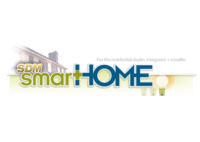There is no sure-bet way concerning wiring, protocols, proprietary and open standards when it comes to home networking. Most often a number of wired and wireless methods coexist or run separately. Still, it is obvious that entertainment video, the smart grid, intelligent appliances, the Internet and a growing attraction by homeowners to receive information and control things through mobile devices are all influencing the future. Here are some thumbnails of existing and emerging approaches.
ZigBee
ZigBee is a specification for a suite of high level communication protocols using small, low-power digital radios based on the IEEE 802.15.4-2003 standard for low rate wireless personal area networks (PAN), such as wireless light switches with lamps, electrical meters with in-home-displays, consumer electronics equipment via short-range radio needing low rates of data transfer. The ZigBee Alliance is an open, non-profit association of members comprised of businesses, universities and government agencies. At zigbee.org
Z-Wave
Z-Wave is a proprietary (from Sigma Designs) wireless communications protocol for home automation, specifically to remote control applications in residential and light commercial environments. The technology uses a low power RF radio embedded or retrofitted into home electronics devices and systems, such as lighting, home access control, entertainment systems and household appliances. The Z-Wave Alliance is an international consortium of manufacturers. At z-wavealliance.org
Wi-Fi
Wi-Fi, a trademark of the Wi-Fi Alliance, is within enabled devices such as a personal computer, video game console, smartphone, or digital audio or video player. They connect to the Internet when within range of a wireless network connected to the Internet. The alliance has generally enforced its use to describe only a narrow range of connectivity technologies including wireless local area networks (WLAN) based on the IEEE 802.11 standards, device to device connectivity such as Wi-Fi Peer to Peer, and a range of technologies that support PANs, local area network (LAN) and even wide area network (WAN) connections. At wi-fi.org
Wi-Gig
The Wi-Gig specification enables high performance wireless data, display and audio applications that supplement the capabilities of today’s wireless LAN devices. Wi-Gig tri-band enabled devices, which operate in the 2.4, 5 and 60 GHz bands, deliver data transfer rates up to 7 Gbps, more than 10 times faster than the highest 802.11n rate while maintaining compatibility with existing Wi-Fi devices. Additionally, the technology was designed to support a multitude of applications on both low power and high performance devices, including consumer electronics, PCs, handheld devices, streaming video and home networking equipment. The Wireless Gigabit Alliance adopter members develop wireless products that use the unlicensed 60 GHz spectrum. At wirelessgigabitalliance.org
WiMAX and WiMAX Advanced
WiMAX (Worldwide Interoperability for Microwave Access) is a telecommunications protocol that provides fixed and mobile Internet access. The current WiMAX revision provides up to 40 Mbits with the IEEE 802.16m update expected to offer up to 1 Gbits fixed speeds. The name WiMAX was created by the WiMAX Forum, which describes it as "a standards-based technology enabling the delivery of last mile wireless broadband access as an alternative to cable and DSL." At wimaxforum.org
4G LTE
In telecommunications, 4G LTE (Long Term Evolution) is the fourth generation of cellular wireless standards. It is a successor to the 3G and 2G families. 4G LTE and WiMAX are moving to meet standards as set through ITU-R IMT-Advanced (International Mobile Telecommunications Advanced) requirements for 4G standards, setting peak speed requirements for 4G service. See IMT-Advanced elsewhere in this sidebar. A 4G system is expected to provide a comprehensive and secure all-IP based mobile broadband solution to laptop computer wireless modems, smartphones, and other mobile devices. Facilities such as ultra-broadband Internet access, IP telephony, gaming services, and streamed multimedia may be provided to users.
IMT-Advanced
International Mobile Telecommunications-Advanced (IMT-Advanced) systems are mobile systems that include the new capabilities of IMT that go beyond those of IMT-2000. Such systems provide access to a wide range of telecommunication services including advanced mobile services, supported by mobile and fixed networks, which are increasingly packet-based.
IMT-Advanced systems support low to high mobility applications and a wide range of data rates in accordance with user and service demands in multiple user environments. IMT Advanced also has capabilities for high quality multimedia applications within a wide range of services and platforms, providing a significant improvement in performance and quality of service. At itu.int
UPnP
Universal plug and play (UPnP) is a set of networking protocols for primarily residential networks without enterprise class devices that permits networked devices, such as personal computers, printers, Internet gateways, Wi-Fi access points and mobile devices to seamlessly discover each other's presence and establish functional network services for data sharing, communications and entertainment. It is promoted by the UPnP Forum. At upnp.org
G.hn
G.hn is the common name for a home network technology standard developed under the International Telecommunication Union (ITU-T) and promoted by the HomeGrid Forum. It supports networking over powerlines, phonelines and coaxial cables with data rates up to 1 Gbit/s. At homegridforum.org
OpenADR
Aimed at energy management, demand response is a set of actions taken to reduce load when electric grid contingencies threaten supply-demand balance or market conditions occur that raise electricity costs. Automated demand response (ADR) consists of fully automated signaling from a utility, electrical independent system operators and regional transmission organizations (ISO/RTO) or another appropriate entity to provide automated connectivity to customer end-use control systems and strategies. OpenADR provides a foundation for interoperable information exchange to facilitate automated demand response. The OpenADR Alliance is comprised of industry stakeholders for demand response communication protocol. At openadr.org
OpenHAN
The OpenHAN suite of standards for home area networks and home grids is promoted by the OpenAMI (automated meter reading) and UtilityAMI. Both efforts aim to standardize powerline networking interoperation from a utility point of view and ensure reliable communications co-extant with AC power outlets. Both utilities and vendors of home control have promoted such standards. The OpenHAN label usually denotes standards favored by the utilities and distinguished from the OpenADR standards that aim to ensure open access to customer electricity use data by service providers. At osgug.ucaiug.org
Bluetooth
Bluetooth is a proprietary open wireless technology standard for exchanging data over short distances (using short wavelength radio transmissions) from fixed and mobile devices, creating PANs with high levels of security. Created by Ericsson, it was originally conceived as a wireless alternative to RS-232 data cables. It can connect several devices, overcoming problems of synchronization. It is managed by the Bluetooth Special Interest Group, with member companies in telecommunication, computing, networking, and consumer electronics. At bluetooth.org
LonWorks
LonWorks is a proprietary networking platform specifically created to address the needs of control applications. The platform is built on a protocol created by Echelon Corporation for networking devices over media such as twisted pair, powerlines, fiber optics, and RF. It automates various functions within buildings such as lighting and HVAC. Peer-to-peer architecture means there's no need for a central computer or controller. At lonmark.org
X10
X10 is an international and open industry standard for communication among electronic devices for home automation. It primarily uses powerline wiring for signaling and control, where the signals involve brief radio frequency bursts representing digital information. A wireless radio based protocol transport is also defined. X10 was developed by Pico Electronics remote control home devices and appliances.
HomePlug
HomePlug is a broad name for various powerline communications standards that support networking over existing home electrical wiring. Several different standards fall under the HomePlug umbrella. Some target broadband applications such as in-home distribution of TV, gaming, and Internet content, while others focus on low power and extended operating temperatures for applications such as smart power meters and in-home communications between electric systems and appliances. The HomePlug Powerline Alliance owns the HomePlug trademark. At homeplug.org
IPv4 and 6
Internet Protocol version 6 (IPv6), to succeed IPv4, operates by transferring data in small packets that are independently routed across networks. Each data packet contains two numeric addresses that are the packet's origin and destination devices. Since 1981, IPv4 has been the publicly used version of the Internet Protocol. IPv6 allows for vastly more numerical addresses, but switching from IPv4 to IPv6 is challenging. 6to4 is an Internet transition mechanism for migrating from IPv4 to IPv6, a system that allows IPv6 packets to be transmitted over an IPv4 network. The IPSO Alliance promotes IP for smart object communications. Smart objects are small computers with a sensor or actuator and a communication device, embedded in objects such as thermometers, car engines, light switches, appliances, and machinery for applications such as home automation, building automation, smart cities, structural health management systems, smart grid and energy management. At ipso-alliance.org
Three-Tier IP Gateways
There is architecture for internetworking between home automation networks and a TCP/IP based wide area network, such as the Internet. The architecture abstracts the functionality of any home network into a driver layer (tier one), and provides a common access layer (tier two) from any TCP/IP network application (tier three) to a local home automation network. Clients and application programs may transparently access services and resources on the home network and appliances connected to the home network may access resources and services on the TCP/IP network.
BACnet
BACnet is a communications protocol for building automation and control networks. It is an ASHRAE, ANSI, and ISO standard protocol. It was designed to allow communication of building automation and control systems for applications such as heating, ventilating, and air conditioning control, lighting control, access control, and fire detection systems and their associated equipment. The protocol provides mechanisms for computerized automation devices to exchange information, regardless of the particular building service they perform. At bacnetinternational.org
Coaxial
Coaxial cable, or coax, is used as a transmission line for radio frequency signals in numerous applications.
CAT 5, 5e and 6
Category 5 cable (Cat 5) is a twisted pair high signal integrity cable type used in structured cabling for computer networks as well as telephony and video. Most Category 5 cables are unshielded, relying on the twisted pair design for noise rejection. Category 5 has been superseded by the Category 5e spec. Category 6 cable is for gigabit Ethernet and other network physical layers that is backward compatible with the Category 5/5e and Category 3 cable standards.
HDMI
High definition multimedia interface is a compact audio/video interface for transmitting uncompressed digital data and a digital alternative to consumer analog standards such as radio frequency coaxial cable, composite video, S-video, component video, D-Terminal, or VGA. HDMI connects digital audio/video sources (set-top boxes, upconvert DVD players, HD DVD players, Blu-ray disc players, AVCHD camcorders, personal computers, video game consoles such as the PlayStation 3 and Xbox 360, and AV receivers) to compatible digital audio devices, computer monitors, video projectors and digital televisions. HDMI follows the EIA/CEA-861 standards. It supports, on a single cable, any uncompressed TV or PC video format, including standard, enhanced and high definition video; up to 8 channels of compressed or uncompressed digital audio; a consumer electronics control (CEC) connection; and an Ethernet data connection. The CEC allows HDMI devices to control each other when necessary and allows the user to operate multiple devices with one remote control handset.
Fiber
Fiber optic communication is a method of transmitting information from one place to another by sending pulses of light through an optical fiber. The light forms an electromagnetic carrier wave that is modulated to carry information.



